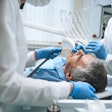
Knowing which medications are safe to prescribe for patients who are pregnant or breast-feeding can present a challenge for dental professionals.
But an article in the latest Journal of the American Dental Association can serve as a useful reference when prescribing medication for these dental patients (August 2012, Vol. 143:8, pp. 858-871).
"Healthcare professionals who are prepared with evidence-based information about the safety of medication use during pregnancy and breast-feeding can advise their patients regarding optimal medication therapy, thereby helping to ensure health outcomes for both mother and baby," wrote study authors Mark Donaldson, BSP, PharmD, and Jason H. Goodchild, DMD.
While dental practitioners prescribe a relatively small group of medications, the authors emphasized that dentists should be familiar with the risks and benefits of five types: analgesics/anti-inflammatories, antibiotics, local anesthetics, sedatives, and emergency medications.
Drs. Donaldson and Goodchild conducted their literature review using searches of Medline, PubMed, Embase, and the Cochrane Database of Systematic Reviews; in addition, they evaluated journals, websites, textbooks, studies, reports, conference proceedings, consensus statements, and abstracts published in English. They focused specifically on the last 50 years "because much of the newer information continues to reference older, original studies."
Pregnancy risk factors
To determine the risks associated with the use of drugs in pregnancy, the U.S. Food and Drug Administration (FDA) traditionally has classified drugs on the basis of the level of risk they pose to the fetus, Drs. Donaldson and Goodchild noted. Drugs in categories A and B are considered safe, whereas drugs in category C may be used only if the benefits outweigh the risks. Drugs in category D should be avoided except in certain exceptional circumstances, while the use of drugs in category X by pregnant women is strictly prohibited.
"The aim when prescribing medication to a pregnant patient is to balance the risks of the drug's potential adverse effects (usually on the fetus) with the benefit (usually to the mother) of treating the disease," the doctors wrote.
They also recommend trying to avoid prescribing medication during the pregnant patient's first trimester, prescribing drugs that have already been used extensively by pregnant women, and prescribing the minimum dose required to obtain the desired effect.
Analgesics and antibiotics
For example, with regard to analgesics and anti-inflammatories, research has shown that taking ibuprofen during pregnancy may cause embryonic implantation disturbances and could lead to maternal pulmonary hypertension. In addition, taking glucocorticoids such as prednisone or dexamethasone during the first trimester has been associated with oral clefts. Thus, these medications have all been labeled as pregnancy risk factor C or D by the FDA.
On the basis of three large-scale epidemiologic studies, the safest analgesic in a pregnant patient is acetaminophen, according to Drs. Donaldson and Goodchild.
With narcotics such as codeine, hydrocodone, and oxycodone, oxycodone appears to be the safest with regard to pregnancy risk; it is listed as a risk factor B, while the other two are listed as risk factor C.
With regard to antibiotics, "some antibiotics (such as tetracyclines and doxycycline) can cross the placental membrane and be deposited in the embryo's bones and teeth at sites of active calcification," the authors wrote. Research has shown that as little as 1 gram per day of tetracycline hydrochloride administered during the third trimester of pregnancy can produce yellow staining of both primary and secondary teeth (Journal of Dental Research, July 2005, Vol. 84:7, pp. 596-602).
Another antibiotic, clarithromycin, is listed as a pregnancy risk factor C and should not be used in pregnant women except in clinical circumstances in which no alternative therapy is appropriate. All other antibiotics commonly used in dentistry -- amoxicillin, azithromycin, cephalexin, clindamycin, erythromycin, metronidazole, and penicillin -- are considered risk factor B.
Anesthetics and sedatives
In general, there are no contraindications to the careful use of lidocaine with epinephrine or prilocaine in pregnant patients, although all local anesthetics used in dentistry can cross the placental barrier, Drs. Donaldson and Goodchild noted. However, while lidocaine and prilocaine are considered risk factor B, articaine, bupivacaine, and mepivacaine are all listed as risk factor C.
Most topical anesthetics used in dentistry also are listed as risk factor C, with the exception of lidocaine, which is risk factor B. Drs. Donaldson and Goodchild recommend that practitioners use benzocaine and tetracaine preparations with caution in pregnant women.
Benzodiazepines are considered quite risky for use by pregnant or breast-feeding women and their babies. The effects of using these drugs during pregnancy may lead to fetal abortion, malformations, intrauterine growth retardation, functional deficits, carcinogenesis, and mutagenesis, with the greatest risks occurring between two and eight weeks after conception. In fact, the FDA lists these medications -- such as alprazolam (Xanax), diazepam (Valium), lorazepam (Ativan), midazolam (Versed), and triazolam (Halcion) -- as risk factor D/X.
Two nonbenzodiazepines -- zaleplon and zolpidem -- are listed as risk factor C; "if a pregnant or breast-feeding patient requires an oral sedative to help her relax throughout her dental appointment, either of these agents would be preferable to the benzodiazepines," the authors wrote.
Emergency medicines
Of all the emergency medicines one might encounter in the dental office, albuterol for the treatment of asthma or other acute bronchospasms is likely the most common. Even so, albuterol is listed by the FDA as a pregnancy risk factor C, and researchers have observed an increase in the risk of congenital malformation association with the use of this drug during pregnancy.
However, because pregnant women with untreated asthma are at much higher risk of experiencing adverse pregnancy outcomes, "In an emergency situation, the benefits to the mother exceed the risk to the fetus, and this medication needs to be administered," Drs. Donaldson and Goodchild wrote.
Similar guidelines apply to several other emergency medications, they added, including epinephrine, naloxone, flumazenil, and nitroglycerin.
Breast-feeding exceptions
With the increase in the rate of breast-feeding, more patients are inquiring about the safety and potential toxicity of drugs and chemicals that may be excreted in breast milk, Drs. Donaldson and Goodchild noted.
For most drugs, the infant is exposed to a much higher concentration during pregnancy than during lactation, so if a drug is considered acceptable for using during pregnancy, it is usually reasonable to continue its use during breast-feeding, they added.
"However, there are exceptions," they emphasized.
For example, while ibuprofen and other analgesics have been found to be safe to use when breast-feeding, daily doses of more than 100 mg of aspirin should be avoided because of the associated risk of platelet dysfunction and Reye's syndrome. With regard to narcotics, codeine is considered the safest to use while breast-feeding, according to the American Academy of Pediatrics (AAP), while hydrocodone and oxycodone carry a higher risk of causing sedation and respiratory depression in the infant.
Similar cautions apply to the use of certain antibiotics by women who are breast-feeding. All tetracyclines, including doxycycline, are excreted in breast milk, and the manufacturers of these products do not recommend taking these medications while breast-feeding to avoid potential tooth staining. The manufacturer of clarithromycin also recommends that caution be exercised when administering this antibiotic to breast-feeding women.
All other antibiotics commonly used in dentistry -- amoxicillin, azithromycin, cephalexin, clindamycin, erythromycin, metronidazole, and penicillin -- are considered by the AAP to be compatible with breast-feeding, with the exception of metronidazole, according to Drs. Donaldson and Goodrich. They also recommend using erythromycin with caution "as this drug is concentrated in human milk and there are documented cases of pyloric stenosis being induced in the breast-fed newborn."
With regard to anesthetics, lidocaine (with epinephrine) and prilocaine are both considered compatible with breast-feeding, according to the AAP, even in doses exceeding the maximum allowed in humans. However, articaine is not considered compatible with breast-feeding. While no studies describing the use of epinephrine during human lactation have been published, "because of its short half-life, it is unlikely that epinephrine distributes into breast milk," Dr. Donaldson and Goodchild wrote.
Similar to the recommendations involving the use of benzodiazepines by pregnant women, the AAP does not consider most benzodiazepines to be compatible with breast-feeding. However, the pump-and-discard method sometimes used for short-acting benzodiazepines such as midazolam and triazolam has been successful for some patients, the authors noted.
"Infant exposure is reduced if breast-feeding is avoided during times when the mother receives sedative medications," they wrote. "However, because relatively small amounts of the drug are excreted into breast milk, some mothers may opt to continue nursing after weighing the benefits of breast-feeding against the potential risk to the infant."
In the long run, "A trusting, open relationship between the dentist and patient is of vital importance to optimize the mother's treatment during her pregnancy," the authors concluded. "In particular, dentists should help pregnant or breast-feeding patients understand all of the risks and benefits before they use any prescribed medication."



















